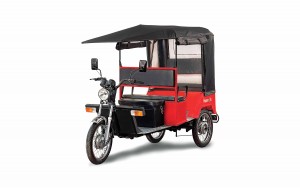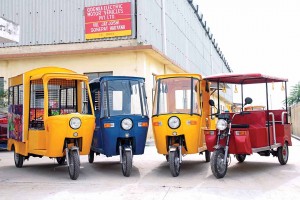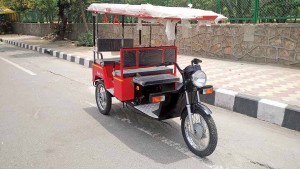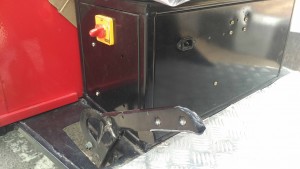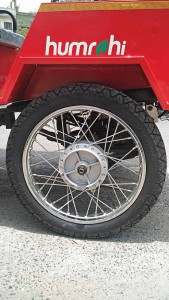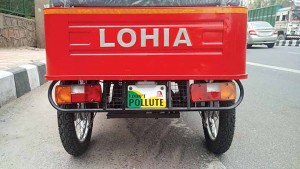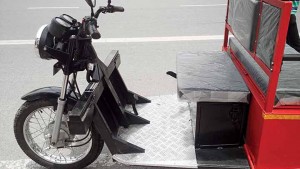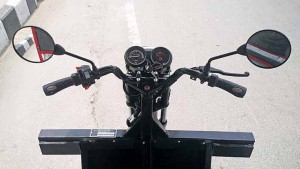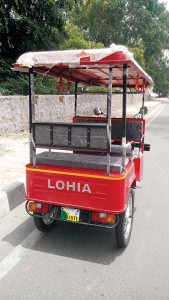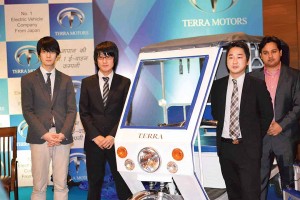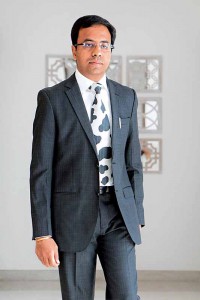erickshaws are proliferating, bringing with them a hope for a greener and economically stable future.
Story by:
Anirudh Raheja
Hailing from Muzzaffarpur, a small town in Bihar, Dalbeer Kumar drives an erickshaw. Until three months ago he used to pull a cycle rickshaw in the scorching heat and freezing cold of Delhi NCR. He earned between Rs.300 and Rs.350 per day pulling a cycle rickshaw. In case of the erickshaw, Dalbeer’s daily income has risen two-folds, and this does not include the Rs.300 rent he pays per day for hiring an erickshaw. Worldly wise, Dalbeer is not keen to buy his own erickshaw as he thinks that it will be obsolete in less than three years. Happy and feeling relieved to be away from the inhuman conditions under which be pulled a cycle rickshaw, Dalbeer does not seem to be bothered by the fact that erickshaws do not comply with the legal aspects of the Motor Vehicle Act. He is instead concerned about the daily expenses he incurs operating an erickshaw, including the amount spent on electricity to charge the batteries overnight. Dalbeer is not alone. There are hundred such erickshaw operators in Delhi NCR who have warmed up to erickshaws, and are finding it a means to feed their families as well as lead a better life.
Last mile connectivity; an integral part of life
For people living in the Delhi National Capital Region, erickshaws have become an integral part of their daily travel. The connectivity that an erickshaw offers takes such precedence that any thought about it being illegal is pushed to the rear. A big reason for the proliferation of erickshaws is how cost effective they are. Providing last mile connectivity, erickshaws over cycle rickshaws are faster and almost noiseless. They do not emit either, and even though the source of electricity that they consume makes them liable for scrutiny in terms of emissions. What began as an unorganised industry that would source parts from China to assemble erickshaws and offer them has turned into a fairly organised trade with the entry of private manufacturing firms in the last few years. Their entry could be linked with the encouragement towards using alternate fuel vehicles by the current government to an extent. The long pending amendment of erickshaws into the Motor Vehicle Act took place last year. The rate of proliferation of erickshaws have since gone up. From amounting to minuscule numbers a few years back, the industry today stands at an estimated 36,000 unit sales per annum. This does not include the sales per centage of the unorganised part of the industry, which is claimed to be a whopping 90 per cent. The good part is, the organised players are not leaving any stone unturned to grab a larger pie of the rising erickshaw market. The government, claim industry sources, is aiming to graduate to a 100 per cent electric vehicle nation by the year 2030.
MoRTH notification
Under the Ministry of Road Transport and Highway (MoRTH) notification of October 2014, an erickshaw operated legally should be battery operated with dimensions not exceeding 2800 mm in length, 1800 mm in width and 1000 mm in height. It should have a seating capacity of four excluding the driver. The maximum luggage carrying capacity should be 40 kgs. The erickshaw should be registered, and have a contract carriage permit. The person operating an erickshaw should hold a valid driving license. The ground situation, it is clear, is different after talking to a few erickshaw operators. A good deal of erickshaws out there do not seem to carry a license plate. Compliance, it does not take long to find out, is low. The reason for this is said to be the availability of lesser erickshaws at 60 per cent of the cost of a regularised erickshaw. With erickshaws finding their way into various states of India, state governments like Haryana, Rajasthan and Karnataka seem to be keen to channelise the industry. Good support seems to be coming from these states even with states like Delhi lowering VAT on such vehicles to five per cent. Delhi Government is also known to have offered financial support of Rs.30,000 for erickshaw retrofitment as per the norms of the transport department, and a subsidy of Rs.15,000 for registration of erickshaws. To increase penetration in areas like Punjab, vehicle manufacturers have been asking for exemption of VAT, which hovers at 14.30 per cent. Demand for erickshaws from southern states is not as strong yet. Not the one to lose hope, players from the organised part of the trade are hopeful of the demand picking up in South India as well. When it does, they are prepared to grab a market share.
Changing environment
Competition in the organised part of the erickshaw industry is growing. It it attracting the entry of foreign players like Sweden’s Clean Motion and Japan’s Terra Motors. In the last six months, there has been a slew of eco-friendly products from the organised part of the industry. Most are, it is clear, targeting last mile connectivity. And, it is not so much about cargo movement as it is about moving people. Noida-based Lohia Auto launched ‘Narain’ series of erickshaws that flaunt a chain-drive, to transmit power and torque to the rear wheels. The advantage of employing a chain-drive is claimed to be durability and costs apart from a longer motor and battery life. Suspension is hydraulic for a more pliant ride. Rated top speed is 25kmph. A brushless electric motor is used, and the battery is of the 105-milliampere hour capacity. Powering the ‘Narain’ erickshaw is a 1,950-watt BLDC geared motor for both, the passenger and cargo version. Last year, Lohia Auto launched ‘Humrahi’ erickshaw series. This one’s powered by a 80 or 100-ampere hour lead acid battery. “The central government is getting serious about the success of electric vehicles. More and more states are asking for regularising erickshaws. It is necessary to go step-by-step and develop a strong foothold. Once the channel is standardised, it will have the right environment to grow faster,” said Ayush Lohia, CEO, Lohia Auto Industries. The manufacturing facility of Lohia Auto at Kashipur in Uttarakhand is capable of producing one-lakh units of two-wheelers, diesel three-wheelers and erickshaws. The current rate of operation is approximately 20 per cent of the capacity. By the end of this fiscal, Lohia Auto plans to hike it to 35 per cent.
With an investment of Rs.30 crore, Pune-based Kinetic Green wants to keep ahead of the competition. The company won an order of Rs.400 crore recently for the supply of erickshaws under Uttar Pradesh’s ‘Yojna’ erickshaw scheme. Kinetic would be supplying 27000 units of its Safar model, which has been approved by ARAI. Questions sent to the company failed to elicit response till the time of going to press.
Ecological baggage
Pointing at the rising potential of erickshaws as well as the government push for electric vehicles, an industry expert questioned the ecological baggage presented by lead acid batteries, their cyclability, and if Lithium-ion batteries is the way to the future. He opined that IPR will hold the key to the development of new technologies and products in the erickshaw space. Said Zafar Equbal, CEO of Sonipat-based Goenka Electric Motor Vehicle, that it is important to visualise the needs of the potential customer. He added, “For our erickshaws which are powered by lead acid batteries, we have also developed a concept of battery bank with our dealers, which can replace the ‘drained’ batteries with charged ones within a few minutes and help the erickshaw operator clock the maximum uptime.” Financing of erickshaws continues to be challenge. Even in case of those that are offered by the organised part of the market. Averred Equbal, “By understanding the need for providing vehicles at easy finance schemes we have also tied up with Punjab National Bank to push erickshaw sales pan-India.”
Zbee’s producer Clean Motion India has invested Rs.6.3 crores in a facility at Faridabad. Plans are said to be underway to increase the investment ten fold by the end of next year. Homologated under the L5 category of International Centre for Automotive Technology (ICAT), the Zbee flaunts a fibre reinforced plastic body, which limits the kerb weight to 270 kgs. This allows it to attain a stop speed of 45 kmph. According to Anil Arora, Country Head, Clean Motion India, the Zbee is assembled in India from CKD kits that are imported from Sweden. “We will touch a localisation level of 70 per cent before the year ends. This would help us to bring down the cost by 50 per cent,” mentioned Arora. Close to 10 Zbees are already plying in Gurgaon at DLF CyberHub. According to Arora, 1,000 units of Zbee will hit the market before the end of FY2017. The Y4 Alfa erickshaw that Terra Motors has introduced in the first quarter of 2016 is fully compliant with the regulations of MoRTH and is also ARAI certified. It was developed with local R&D support and carries high localisation level of 95 per cent to keep costs down. Though the company is currently importing the rear axle from China, according to Kohei Oishi, Director, North India for Terra Motors, in the next three to four months, 100 per cent localisation will be achieved. “Quality testing is going on for various parts,” he mentioned. Aware of the market for such vehicles growing, Oishi claims that Terra Motors will appoint new dealers in the current financial year.
Challenges ahead
erickshaws from the unorganised part of the industry continue to be a big impediment for the growth of organised players. One erickshaw from an organised player costs Rs. one-lakh or more. That of a player from the unorganised part costs Rs.70,000. This is perhaps the reason why many organised players have not been able to make money. Despite aiming at higher localisation, organised players have not been able to achieve good return on investment. Also, the vehicles bought from organised players being legal give rise to other challenges like vehicle registration and permit procurement. “The government has to come forward. They have the capability. There is no subsidy on erickshaws under the FAME outlay. If there was, manufacturers would have been able to break even. Even today, erickshaw manufacturers are finding it tough to crack the market,” said Lohia. Even though Lithium-ion batteries offer better performance and life, most erickshaw manufacturers are packaging lead acid batteries. This stems from the fact that erickshaw buyers continue to be cost averse. “Lithium-ion batteries cost six times more than a typical lead acid battery. It costs almost the same it takes to buy an erickshaw with lead acid battery in it. There is not much demand for Lithium-ion batteries therefore,” said Equbal. Zbee is perhaps the only erickshaw as of current that comes with an advanced Lithium-ion battery as standard. It can be quickly recharged in two hours for a 50 km run.
The need to recharge the batteries of an electric vehicle is its biggest limiting factor. Not because they have to be charged, but because it takes a good amount of time to charge them. The need to charge them regularly calls for an efficient supporting infrastructure. Stressing upon this very need, Sohinder Gill, CEO, Hero Electric India, averred that charging stations at multiple locations will play a crucial role in the development of the erickshaw market. “Due to lack of support, people are forced to use the electricity primed for domestic use that ultimately results in power theft,” he added. Gill expressed that there is a need to incentivise erickshaw manufacturers to encourage them to produce green vehicles. Said Oishi, “Power and mileage matter most for an erickshaw operator. It is very important to focus on these two factors to reduce the cost of operations. Since battery is one of the most expensive parts in an erickshaw, it is set to play a crucial role in determining the sales.” Experts assert that erickshaws technically have less constraints as compared to other automobiles. Reforms and changes in terms of safety, they add, has the chance of adversely affecting the industry where the organised players are plagued by low returns. The issue of reforms would have to be tackled carefully and swiftly therefore.
Awareness is the key
In some parts of the nation, even the distribution channel for the organised players is seen gasping for breath. Despite aggressive marketing, manufacturers seem cautious to expand to newer markets. The reason perhaps is the pending approvals in south Indian states. This merits a question: If there is a need to create awaraness about erickshaws and their abilities to serve the missing link in last mile connectivity? The Central Government is pushing erickshaws, but the states should also respond favourably. Under the Pradhan Mantri Mudra Yojna, prime minister Narendra Modi distributed 5100 erickshaws in Uttar Pradesh recently. Lucknow-based micro credit firm Bhartiya Micro Credit has agreed to finance 2000 units of erickshaws, which will be available at a daily installment of less than Rs.250 for two years. Despite a lucrative deal, less than ten takers turned up for the completion of registration of such vehicles. No more than 400 learning driving licences have been issued for erickshaws. Under such circumstances, the need to create awareness is of utmost importance. Most organised players are of the opinion that tier 1 and tier 2 cities will be their playground in the near future as they get smarter. Smart cities initiative will take some time. Until then, it may be worth taking the trouble of charting out a role for erickshaws as a non-polluting means of last mile connectivity. The best place to start then is to build a sound infrastructure and create value for all stakeholders.
Driving Lohia Humrahi
From a 49-tonne heavy-duty truck to a humble erickshaw, commercial vehicles in India come in the most weirdest of shapes and sizes. As commercial vehicles they help to transport cargo and people. The erickshaw in particular has come to replace the three-wheeler cycle rickshaws as a modern zero-emissions form of last mile transportation. Call it extenstion of the spoke, the erickshaw looks set to further define the hub and spoke transportation model in India. Not quite like the stylish Renault ZOE in Europe, the humble Indian erickshaw is about form following function. Unveiled at the Auto Expo 2014, Lohia’s Humrahi has carved out a niche for itself in a highly fragmented market. Certified by the Automotive Research Association of India, Humrahi, in terms of appearance, fails to turn heads. It looks similar to erickshaws offered by the unorganised market. A closer look however reveals that this one is built stronger and better. Adhering to the specifications put in place by the MoRTH for erickshaws, Humrahi measures 2660 mm in length and 1000 mm in width. Height is 1800 mm. The mild-steel body of Humrahi is bolted to a square tube chassis for a rigid and strong build. The 1980 mm wheelbase ensures good amount of space. Dominating the front is a big round shaped headlight (by Lumax). The light is placed on a telescopic front fork suspension (by Escorts). The handle is finished in a shade of black. Instruments include two dials. Developed by Axis, one analogue dial indicates acceleration, and the other indicates the battery power level. Flaunting turn indicators at the either corner of the front body panel, Humrahi rides on 17-inch dia. spoke wheels. The tyres are 3.00 – R17 6PR, and sourced from either Metro Continental or Ralco. Mount the erickshaw and the initial feeling is of being in charge of something that is slender at front and much wider at the rear. The good part is, the driver’s seat is placed ergonomically, and the quality of upholstery is good. If this should enable the driver to spend long hours ferrying passengers or cargo, the rear view mirrors offer a good view. The quality of switchgear is good. The aluminium flooring looks appealling. A knob, coloured bright red, on a yellow square panel under the seat, draws attention. It is placed to the right. It is a transfer switch and facilitates forward and reverse movement. Care has been taken to ensure that the driver brings the vehicle to a halt before engaging the drive. Also under the driver’s seat is the socket for battery charging. Charging happens with a 65 volt, 12 ampere three-stage charger sourced from Axiom. The brake pedal juts out of the floor, and the parking break lever is placed to the right side of the driver’s seat. Like in the case of a motorcycle, the erickshaw accelerates by twisting the throttle. Just that there are no gears to operate.
At the rear, there are two bench seats facing each other. Four people can seat across the two seats. The seating position is upright, and the amount of leg room on supply is good. It is easy for people to board and alight. There’s no feeling of the passenger compartment being cramped. Instead of the passenger compartment, the cargo version is fitted with a cargo box. Dominating the rear are two Lumax tail lamps. A soft top does the job of protecting the occupants from the vagaries of nature. Powering Humrahi is a BLDC geared motor located under the floor. Brushless technology is claimed to increase the life of the motor and improve performance. The 100 Ah lead acid battery from Amaron works as a energy storage device, and can be charged in eight to ten hours. On one charge, Humrahi can travel up to 100 kmph. The motor is connected to the rear axle by means of a chain drive. There’s a chain adjuster on offer to cure any slack that develops over a period of use. Braking is mechanical in nature. Linkage rods activate the 130m dia. brake drums. Weighing 400 kg, the cargo version of Humrahi is claimed to offer a payload of close to 400 kgs!
The turn of the key brings Humrahi to life. There is no noise, neither any drama. Twisting the throttle has the erickshaw accelerating smoothly ahead, devoid of any vibration. With no clutch or gears to operate, Humrahi makes an easy machine to pilot. The view ahead is uninterrupted and the wide handlebar offers an opportunity to choose the direction of travel. It takes some time to reach closer to the claimed top speed of 30 kmph. Speeds in the region of 25 kmph are achieved with certain ease. Devoid of any vibrations, the ride is pliant, and the vehicle displays good agility. Humrahi uses quality components. Good stability of the Humrahi has also to do with the use of bigger and stronger bearings: spoke wheels. The braking system exerts good bite.
With the possibility of overloading, either in the case of the passenger carrier version or the cargo version, never ruled out, the erickshaw is claimed to have been suitably engineered. The mechanicals, the electrical and electronics are claimed to have been built to the best quality an erickshaw would have to offer. The fit and finish standards of Humrahi are superior. Lohia Auto has developed a power bank concept where vehicle batteries can be swapped. Claimed to be 98 per cent localised, the rear axle of Humrahi is imported. Costing Rs.1.2 lakh, Humrahi offers more leg room; is reflective of the promise of reliability, safety and lower total operating costs.




